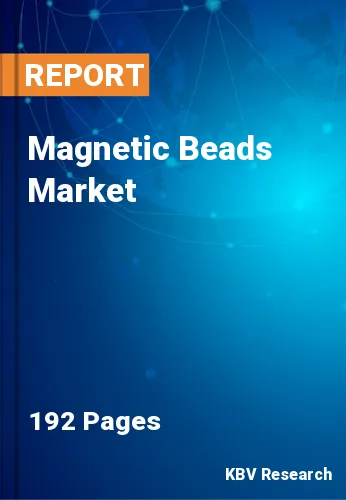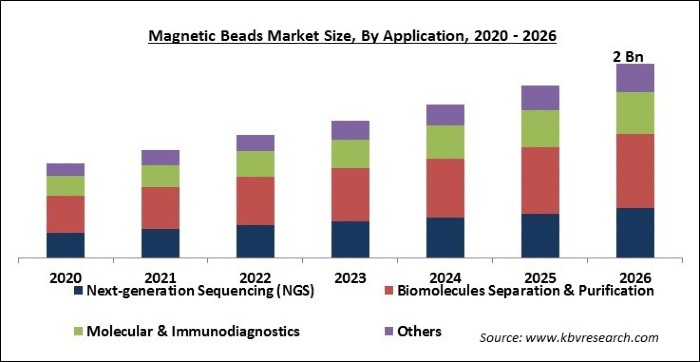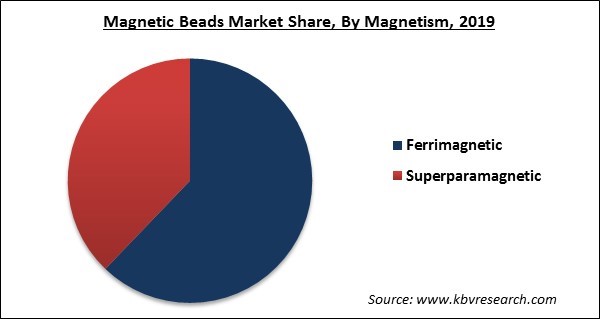
The Global Magnetic Beads Market size is expected to reach $2 billion by 2026, rising at a market growth of 12.7% CAGR during the forecast period. Magnetic beads refer to a tool, which is made up of small particles of iron oxides like magnetite that provide superparamagnetic properties to these beads. They do not attract one another when they are not in the ambit of the magnetic field, which is why they can be easily utilized without any stress about undesirable clumping. Magnetic bead separation is a fast, effective, and clear process which is used by scientists to substitute their filtration & centrifugation and separation methods. Magnetic beads & elements are used with antibodies, antigens, proteins, catalyzers, or nucleic acids, which allow them to bind together cells, viruses, bacteria, and other biological organisms.
They are utilized to offer a reliable and simplified technique of refining various kinds of a biomolecule, like genomic DNA, plasmids, proteins, mitochondrial DNA, and RNA. The growing trend of protein sample preparation and protein purification will open new growth avenues for the magnetic beads market. Factors like shifting preference for in-vitro diagnostic testing, technological enhancements in magnetic beads, and the rising healthcare spending are likely to boost the growth of the magnetic beads market during the forecast period.

Along with that, leading market players are putting high emphasis on introducing various new, advanced, innovative, and effective magnetic beads will spur the market demand. In addition, the COVID-19 pandemic has positively impacted the magnetic beads market because they are considered as the basic tool for research labs, due to which, they have witnessed a hike in their usage.
Based on Magnetism, the market is segmented into Ferrimagnetic and Superparamagnetic. The Ferrimagnetic market dominated the Global Magnetic Beads Market by Magnetism in 2019. The Superparamagnetic market is expected to witness a CAGR of 14.1% during (2020 - 2026).

Based on Size, the market is segmented into Less than 5um, 5-20 um, 20-40 um and 40 um & above. The Less than 5um market dominated the Global Magnetic Beads Market by Size in 2019, growing at a CAGR of 12.1 % during the forecast period. The 5-20 um market is showcasing a CAGR of 11.7% during (2020 - 2026). Additionally, The 20-40 um market is estimated to grow at a CAGR of 14.9% during (2020 - 2026).
| Report Attribute | Details |
|---|---|
| Market size value in 2019 | USD 906 Million |
| Market size forecast in 2026 | USD 2 Billion |
| Base Year | 2019 |
| Historical Period | 2016 to 2018 |
| Forecast Period | 2020 to 2026 |
| Revenue Growth Rate | CAGR of 12.7% from 2020 to 2026 |
| Number of Pages | 192 |
| Number of Tables | 360 |
| Report coverage | Market Trends, Revenue Estimation and Forecast, Segmentation Analysis, Regional and Country Breakdown, Companies Strategic Developments, Company Profiling |
| Segments covered | Magnetism, Size, Application, End User, Region |
| Country scope | US, Canada, Mexico, Germany, UK, France, Russia, Spain, Italy, China, Japan, India, South Korea, Singapore, Malaysia, Brazil, Argentina, UAE, Saudi Arabia, South Africa, Nigeria |
| Growth Drivers |
|
| Restraints |
|
Based on Application, the market is segmented into Next-generation Sequencing (NGS), Biomolecules Separation & Purification, Molecular & Immunodiagnostics and Others. The Biomolecules Separation & Purification market dominated the Global Magnetic Beads Market by Application in 2019, and would continue to be a dominant market till 2026. The Next-generation Sequencing (NGS) market is expected to witness a CAGR of 11.9% during (2020 - 2026).
Free Valuable Insights: Global Magnetic Beads Market to reach a market size of $2 Billion by 2026
Based on Regions, the market is segmented into North America, Europe, Asia Pacific, and Latin America, Middle East & Africa. Europe is anticipated to witness a promising growth rate during the forecast period. This growth is attributed to the increasing awareness among the population regarding health, which further spurred the demand for diagnostics and therapeutic solutions in this region. Moreover, the growing adoption of the product for the diagnosis and treatment of many medical conditions like cancer and brain tumor is estimated to fuel the demand for the product in the regional healthcare industry.
The market research report covers the analysis of key stake holders of the market. Key companies profiled in the report include Thermo Fisher Scientific, Inc., Merck Group, Bangs Laboratories, Inc. (Polysciences, Inc.), Spherotech, Inc., Promega Corporation, Zeesan Biotech Co., Ltd., Vazyme Biotech Co., Ltd., Magbio Genomics, Inc., Calbiotech, Inc. (Erba Diagnostics Ltd. Group), and New England BioLabs, Inc.
By Magnetism
By Size
By Application
By Geography
The global magnetic beads market size is expected to reach $2 billion by 2026.
Shifting preference for in-vitro diagnostic testing are driving the market in coming years, however, Contamination issues of samples with residual magnetic beads have limited the growth of the market.
Yes, the COVID-19 pandemic has positively impacted the magnetic beads market because they are considered as the basic tool for research labs, due to which, they have witnessed a hike in their usage.
Thermo Fisher Scientific, Inc., Merck Group, Bangs Laboratories, Inc. (Polysciences, Inc.), Spherotech, Inc., Promega Corporation, Zeesan Biotech Co., Ltd., Vazyme Biotech Co., Ltd., Magbio Genomics, Inc., Calbiotech, Inc. (Erba Diagnostics Ltd. Group), and New England BioLabs, Inc.
The expected CAGR of the magnetic beads market is 12.7% from 2020 to 2026.
Our team of dedicated experts can provide you with attractive expansion opportunities for your business.
